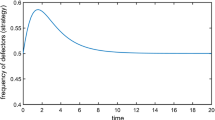Abstract
Game theoretic models, along with replicator equations, have been applied successfully to the study of evolution of populations of competing species, including the growth of a population, the reaching of the population to an equilibrium state, and the evolutionary stability of the state. In this paper, we analyze a game model proposed by Gore et al. (Nature 456:253–256, 2009) in their recent study on the co-development of two mixed yeast strains. We examine the mathematical properties of this model with varying experimental parameters. We simulate the growths of the yeast strains and compare them with the experimental results. We also compute and analyze the equilibrium state of the system and prove that it is asymptotically and evolutionarily stable.









Similar content being viewed by others
References
Aster, R., Borchers, B., & Thurber, C. (2005). Parameter estimation and inverse problems. Amsterdam/San Diego: Elsevier/Academic Press.
Axelrod, R., & Hamilton, W. D. (1981). The evolution of cooperation. Science, 211, 1390–1396.
Diggle, S. P., Griffin, A. S., Campbell, G. S., & West, S. A. (2007). Cooperation and conflict in quorum-sensing bacterial populations. Nature, 450, 411–414.
Durrett, R., & Levin, S. (1997). Allelopathy in spatially distributed populations. J. Theor. Biol., 185, 165–171.
Gore, J., Youk, H., & van Oudenaarden, A. (2009). Snowdrift game dynamics and facultative cheating in yeast. Nature, 456, 253–256.
Griffin, A. S., West, S. A., & Buckling, A. (2004). Cooperation and competition in pathogenic bacteria. Nature, 430, 1024–1027.
Hauert, C., & Doebeli, M. (2004). Spatial structure often inhibits the evolution of cooperation in the snowdrift game. Nature, 428, 643–646.
Hofbauer, J., & Sigmund, K. (1998). Evolutionary games and population dynamics. Cambridge: Cambridge University Press.
Kerr, B., Riley, M. A., Feldman, M. W., & Bohannan, B. J. M. (2002). Local dispersal promotes biodiversity in a real-life game of rock–paper–scissors. Nature, 418, 171–174.
MacLean, R. C., & Gudelj, I. (2006). Resource competition and social conflict in experimental populations of yeast. Nature, 441, 498–501.
Nash, J. (1950). Equilibrium points in n-person games. Proc. Natl. Acad. Sci. USA, 36, 48–49.
Nowak, M. A. (2006a). Evolutionary dynamics: exploring the equations of life. Cambridge: Belknap Press.
Nowak, M. A. (2006b). Five rules for the evolution of cooperation. Science, 314, 1560–1563.
Nowak, M. A., & May, R. M. (1992). Evolutionary games and spatial chaos. Nature, 359, 826–829.
Rainey, P. B., & Rainey, K. (2003). Evolution of cooperation and conflict in experimental bacterial populations. Nature, 425, 72–74.
Santorelli, L. A., et al. (2008). Facultative cheater mutants reveal the genetic complexity of cooperation in social amoebae. Nature, 451, 1107–1110.
Smith, J. M., & Price, G. R. (1973). The logic of animal conflict. Nature, 246, 15–18.
Von Neumann, J., & Morgenstern, O. (1944). Theory of games and economic behavior. Princeton: Princeton University Press.
Webb, J. N. (2007). Springer undergraduate mathematics series. Game theory: decisions, interaction and evolution. Berlin: Springer.
West, S. A., Griffin, A. S., Gardner, A., & Diggle, S. P. (2006). Social evolution theory for microorganisms. Nat. Rev., Microbiol., 4, 597–607.
Acknowledgements
We would like to thank Prof. Jeff Gore for kindly giving us the Matlab code for generating some of the graphical results in their paper and for providing helpful suggestions and advices for how to proceed in our computation. This work is partially supported by the NIH/ /NIGMS grants R01GM072014 and R01GM081680 and by the NSF/ /DMS grant DMS0914354.
Author information
Authors and Affiliations
Corresponding author
Rights and permissions
About this article
Cite this article
Huang, Y., Wu, Z. Game Dynamic Model for Yeast Development. Bull Math Biol 74, 1469–1484 (2012). https://doi.org/10.1007/s11538-012-9721-5
Received:
Accepted:
Published:
Issue Date:
DOI: https://doi.org/10.1007/s11538-012-9721-5




